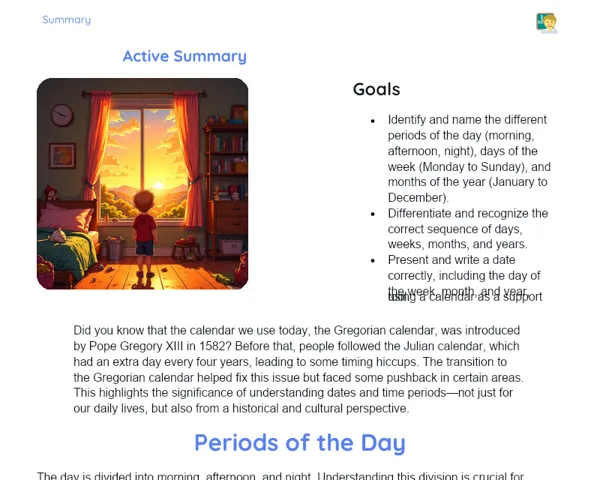Summary Tradisional | Quadrilateral: Rectangle
Contextualization
A rectangle is a familiar shape that plays an important role in geometry. It's classified as a quadrilateral with four right angles, which means each angle measures 90 degrees. This feature ensures that the opposite sides of a rectangle are parallel and equal in length. These characteristics make rectangles incredibly useful in various fields like geometry, architecture, and design. In our everyday lives, we come across rectangles in things like computer screens, posters, books, and even on rugby fields.
Rectangles also come with specific mathematical properties that simplify calculations. For instance, their diagonals are equal in length and intersect right in the middle. Moreover, figuring out the perimeter and area of a rectangle is quite straightforward—just sum the lengths of its sides for the perimeter and multiply the base by the height for the area. Understanding these properties and knowing how to carry out calculations related to rectangles is crucial for tackling practical problems, whether in daily life or professional settings.
To Remember!
Definition of Rectangle
A rectangle is a specific type of quadrilateral that has four right angles, meaning each internal angle measures 90 degrees. This defining feature helps differentiate rectangles from other quadrilaterals like parallelograms and trapeziums.
In addition to the right angles, another key property of rectangles is that their opposite sides are parallel and of equal length. For example, if one side of the rectangle is 5 cm, the opposite side will also measure 5 cm. This consistency makes rectangles a predictable shape, easy to work with in any mathematical calculations.
Due to these properties, rectangles are widely used in various disciplines. In architecture, for instance, many buildings and rooms are designed using rectangles as their foundational shape. In graphic design, screens of electronic devices often take on a rectangular form, which simplifies the visualization and arrangement of elements.
-
Four right angles of 90 degrees.
-
Opposite sides are equal and parallel.
-
Commonly used in architecture and graphic design.
Properties of Rectangles
A standout property of rectangles is that their diagonals are congruent, meaning they are of the same length. The diagonals intersect at the midpoint, effectively creating two congruent right triangles within the rectangle. This property streamlines a lot of calculations and geometric proofs.
Another significant characteristic is that the diagonals not only meet at the midpoint but partition the rectangle into four smaller congruent right triangles, all having equal areas. This feature is especially handy in practical applications like engineering projects and calculating areas and volumes.
Additionally, the symmetry of rectangles lends them remarkable stability and predictability. This symmetry is explored in many fields, including construction—where structural integrity is vital—and in art, where symmetry is often linked to beauty and balance.
-
Congruent diagonals.
-
Diagonals intersect at the midpoint.
-
Symmetry and structural stability.
Calculating Perimeter and Area
To find the perimeter of a rectangle, you add twice the length of the base and twice the height. This is expressed mathematically as P = 2*(base + height). For example, if a rectangle has a base of 8 cm and a height of 5 cm, the perimeter would be 2*(8 + 5) = 26 cm.
The area of a rectangle, on the other hand, is determined by multiplying the base by the height. The formula for the area is A = base * height. Using the same example, if the base is 8 cm and the height is 5 cm, the area will be 8 * 5 = 40 cm². These calculations are fundamental in a multitude of practical applications—from estimating the material required to cover a surface to figuring out the capacity of a room.
Being able to calculate perimeter and area of rectangles is a vital skill in numerous fields, including construction, interior design, and managing household spaces. These simple formulas enable an efficient and accurate approach to a wide array of daily challenges.
-
Perimeter: P = 2*(base + height).
-
Area: A = base * height.
-
Vital in construction and interior design.
Solving Practical Problems
Applying the concepts of rectangles to real-world problems is an effective way to reinforce what we've learned in theory. A common example includes calculating the perimeter and area of rectangular spaces like sports fields, room floors, or walls. These measurements assist in determining how much material is needed to enclose or cover those areas.
Another practical example could be arranging furniture in a rectangular room. Knowing the dimensions of both the room and the furniture allows for thoughtful planning, ensuring that everything fits well and maintains adequate space for movement.
Additionally, in fields like art and graphic design, grasping the properties of rectangles is crucial for crafting balanced and visually appealing layouts. The symmetry and consistency of rectangles facilitate the arrangement of visual components, leading to harmonious and aesthetically pleasing designs.
-
Calculating perimeter and area for material estimation.
-
Planning furniture layout.
-
Creating visual designs in art and graphic design.
Key Terms
-
Rectangle: A quadrilateral with four right angles and opposite sides that are equal and parallel.
-
Right angles: Angles measuring 90 degrees.
-
Congruent diagonals: Diagonals of the same length.
-
Perimeter: The sum of the lengths of the sides of a geometric figure.
-
Area: A measure of the surface of a geometric figure, calculated by multiplying the base by the height.
-
Symmetry: A characteristic of a figure that can be divided into equal and mirrored parts.
Important Conclusions
In this lesson, we delved into the definition and essential properties of rectangles, recognising them as quadrilaterals with four right angles and opposite sides that are both equal and parallel. We examined how these traits render rectangles as reliable geometric figures useful in numerous practical domains like architecture and graphic design.
We also learned to calculate the perimeter and area of rectangles through straightforward formulas. These calculations are critical in addressing practical everyday issues, from measuring materials needed to cover a surface to devising furniture arrangements within a rectangular space. Tackling such practical problems bridges the gap between our theoretical knowledge and real-life applications.
Lastly, we underscored the importance of understanding rectangle properties and being able to apply this understanding in various contexts. Studying rectangles not only clarifies more advanced geometric concepts but is also foundational for numerous careers and daily tasks, including construction, interior design, and space management.
Study Tips
-
Review the concepts and properties of rectangles, focusing on definitions, right angles, equal and parallel opposite sides, and congruent diagonals.
-
Practice calculating the perimeter and area of rectangles with various measurements using the formulas discussed in class.
-
Solve practical problems involving rectangles, such as measuring room areas, planning furniture layouts, or calculating materials needed for covers and enclosures.



